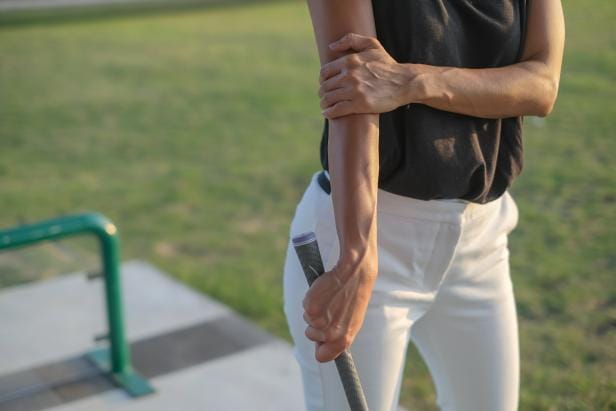Technique adjustments: Sometimes the pain in your elbows is a result of poor technique. If you’re a golfer, consider getting a swing analysis to see if your mechanics are putting unnecessary stress on your joints. A tweak in your stance or grip could make all the difference. Or if you play tennis, have a pro watch your backhand to see if there’s a hitch that’s causing the issue.
Gear check: Are you playing with the right equipment? In golf, the wrong shaft or grip size can cause problems. Make sure you’re using clubs that are suited for your swing and body type. In tennis, a racquet that’s too heavy or has too high of a string tension can contribute to elbow pain. Consult with a professional to make sure you’re using the right gear.
Overhead athlete considerations: If you play a sport that requires a lot of overhead movements, like baseball, volleyball, or swimming, your risk of elbow tendinitis may be higher. In addition to following the previous steps, consider modifying your training to reduce the stress on your joints. Cross-training with activities that don’t strain your elbows can help maintain your fitness level without exacerbating the pain.
Warm-up and cool down: It’s important to properly warm up before engaging in any physical activity. Dynamic stretches and exercises that mimic the movements you’ll be doing in your sport can help prepare your muscles and joints for action. After your workout, take the time to properly cool down and stretch to prevent stiffness and tightness that could worsen your elbow pain.
Nutrition and hydration: Believe it or not, what you eat and drink can play a role in your recovery from elbow tendinitis. Consuming foods rich in anti-inflammatory properties, such as omega-3 fatty acids, can help reduce inflammation in your body. Staying well-hydrated is also important for maintaining healthy muscles and joints. Consider speaking with a nutritionist to create a plan that supports your recovery goals.
Lifestyle modifications: In addition to the physical aspects of managing elbow tendinitis, it’s important to look at your lifestyle habits that may be contributing to the issue. Are you consistently overworking your arms without giving them ample rest? Are you neglecting proper ergonomics in your daily activities? Addressing these underlying causes can help prevent future flare-ups of elbow pain.
Patience and consistency: Recovery from elbow tendinitis takes time and dedication. It’s important to be patient with yourself and follow through with your treatment plan consistently. Skipping exercises or pushing through the pain can set you back in your progress. Listen to your body, rest when needed, and trust the process to allow your elbows to heal fully.
- Prevention for the future: Once you’ve successfully treated your elbow tendinitis, it’s crucial to continue with preventive measures to avoid a recurrence. This includes maintaining a regular exercise routine that focuses on strengthening the muscles around your elbow joint, using proper technique in your sport, and being mindful of any warning signs of overuse. By taking proactive steps to care for your elbows, you can enjoy your favorite activities pain-free for years to come.
Subscribe to Updates
Get the latest golf news and updates directly to your inbox.
The ultimate solution for elbow tendinitis: still the best option today
Related Posts
Add A Comment


